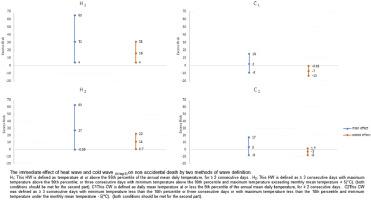当前位置:
X-MOL 学术
›
J. Therm. Biol.
›
论文详情
Our official English website, www.x-mol.net, welcomes your feedback! (Note: you will need to create a separate account there.)
The effect of cold and heat waves on mortality in Urmia a cold region in the North West of Iran
Journal of Thermal Biology ( IF 2.7 ) Pub Date : 2020-12-01 , DOI: 10.1016/j.jtherbio.2020.102745 Rahim Sharafkhani 1 , Narges Khanjani 2 , Bahram Bakhtiari 3 , Yunes Jahani 4 , Rasool Entezarmahdi 5
Journal of Thermal Biology ( IF 2.7 ) Pub Date : 2020-12-01 , DOI: 10.1016/j.jtherbio.2020.102745 Rahim Sharafkhani 1 , Narges Khanjani 2 , Bahram Bakhtiari 3 , Yunes Jahani 4 , Rasool Entezarmahdi 5
Affiliation

|
Few studies have investigated the different extreme temperature effects (heat-cold) of one geographical location at the same time in Iran. This study was conducted to assess the impact of heat and cold waves on mortality in Urmia city, which has a cold and mountainous climate. Distributed Lag Non-linear Models combined with a quasi-Poisson regression were used to assess the impact of heat (HW) and cold waves (CW) on mortality in subgroups, controlled for potential confounders such as long-term trend of daily mortality, day of week effect, holidays, mean temperature, humidity, wind speed and air pollutants. The heat/cold effect was divided into two general categories A-main effect (the effect caused by temperature), B-added effect (the effect caused by persistence of extreme temperature). Results show that there was no relation between HW and respiratory and cardiovascular death, but in main effects, HW(H1) significantly increased, the risk of Non-Accidental Death (NAD) in lag 0 (Cumulative Excess Risk (CER) NAD = 31(CI; 4-65)). Also in added effects, HW had a significant effect on NAD (CER H1; NAD; lag;0-2 = 31(CI; 5, 51), CER H2; NAD; lag;0-2 = 26(CI; 6, 48)). There was no relation between CW and respiratory death and cardiovascular death, but in added effects, CW(C1) significantly decreased, the risk of non-accidental death in initial lags (CER C1; NAD; lag;0-2 = -19 (CI; -35, -2)). It seems that high temperatures and heat waves increase the risk of non-accidental mortality in northwest of Iran.
中文翻译:

寒冷和热浪对伊朗西北部寒冷地区乌尔米亚死亡率的影响
很少有研究同时调查伊朗一个地理位置的不同极端温度效应(热-冷)。本研究旨在评估热浪和寒潮对乌尔米亚市死亡率的影响,乌尔米亚市气候寒冷多山。分布式滞后非线性模型结合准泊松回归用于评估热浪 (HW) 和冷浪 (CW) 对亚组死亡率的影响,控制潜在混杂因素,例如每日死亡率的长期趋势、周效应、节假日、平均温度、湿度、风速和空气污染物。热/冷效应分为两大类:A-主效应(由温度引起的效应),B-附加效应(由极端温度持续引起的效应)。结果表明,HW 与呼吸和心血管死亡无关,但在主效应中,HW(H1) 显着增加,滞后 0 的非意外死亡 (NAD) 风险 (累积超额风险 (CER) NAD = 31) (CI; 4-65))。同样在附加效应中,HW 对 NAD 有显着影响(CER H1;NAD;滞后;0-2 = 31(CI;5, 51),CER H2;NAD;滞后;0-2 = 26(CI;6, 48))。CW与呼吸系统死亡和心血管死亡之间没有关系,但在附加效应中,CW(C1)显着降低,初始滞后(CER C1;NAD;滞后;0-2 = -19)的非意外死亡风险( CI;-35,-2))。高温和热浪似乎增加了伊朗西北部非意外死亡的风险。滞后 0 中非意外死亡 (NAD) 的风险(累积超额风险 (CER) NAD = 31(CI; 4-65))。同样在附加效应中,HW 对 NAD 有显着影响(CER H1;NAD;滞后;0-2 = 31(CI;5, 51),CER H2;NAD;滞后;0-2 = 26(CI;6, 48))。CW与呼吸系统死亡和心血管死亡之间没有关系,但在附加效应中,CW(C1)显着降低,初始滞后(CER C1;NAD;滞后;0-2 = -19)的非意外死亡风险( CI;-35,-2))。高温和热浪似乎增加了伊朗西北部非意外死亡的风险。滞后 0 中非意外死亡 (NAD) 的风险(累积超额风险 (CER) NAD = 31(CI; 4-65))。同样在附加效应中,HW 对 NAD 有显着影响(CER H1;NAD;滞后;0-2 = 31(CI;5, 51),CER H2;NAD;滞后;0-2 = 26(CI;6, 48))。CW与呼吸系统死亡和心血管死亡之间没有关系,但在附加效应中,CW(C1)显着降低,初始滞后(CER C1;NAD;滞后;0-2 = -19)的非意外死亡风险( CI;-35,-2))。高温和热浪似乎增加了伊朗西北部非意外死亡的风险。但在附加效应中,CW(C1) 显着降低了初始滞后期的非意外死亡风险(CER C1;NAD;滞后;0-2 = -19(CI;-35,-2))。高温和热浪似乎增加了伊朗西北部非意外死亡的风险。但在附加效应中,CW(C1) 显着降低了初始滞后期的非意外死亡风险(CER C1;NAD;滞后;0-2 = -19(CI;-35,-2))。高温和热浪似乎增加了伊朗西北部非意外死亡的风险。
更新日期:2020-12-01
中文翻译:

寒冷和热浪对伊朗西北部寒冷地区乌尔米亚死亡率的影响
很少有研究同时调查伊朗一个地理位置的不同极端温度效应(热-冷)。本研究旨在评估热浪和寒潮对乌尔米亚市死亡率的影响,乌尔米亚市气候寒冷多山。分布式滞后非线性模型结合准泊松回归用于评估热浪 (HW) 和冷浪 (CW) 对亚组死亡率的影响,控制潜在混杂因素,例如每日死亡率的长期趋势、周效应、节假日、平均温度、湿度、风速和空气污染物。热/冷效应分为两大类:A-主效应(由温度引起的效应),B-附加效应(由极端温度持续引起的效应)。结果表明,HW 与呼吸和心血管死亡无关,但在主效应中,HW(H1) 显着增加,滞后 0 的非意外死亡 (NAD) 风险 (累积超额风险 (CER) NAD = 31) (CI; 4-65))。同样在附加效应中,HW 对 NAD 有显着影响(CER H1;NAD;滞后;0-2 = 31(CI;5, 51),CER H2;NAD;滞后;0-2 = 26(CI;6, 48))。CW与呼吸系统死亡和心血管死亡之间没有关系,但在附加效应中,CW(C1)显着降低,初始滞后(CER C1;NAD;滞后;0-2 = -19)的非意外死亡风险( CI;-35,-2))。高温和热浪似乎增加了伊朗西北部非意外死亡的风险。滞后 0 中非意外死亡 (NAD) 的风险(累积超额风险 (CER) NAD = 31(CI; 4-65))。同样在附加效应中,HW 对 NAD 有显着影响(CER H1;NAD;滞后;0-2 = 31(CI;5, 51),CER H2;NAD;滞后;0-2 = 26(CI;6, 48))。CW与呼吸系统死亡和心血管死亡之间没有关系,但在附加效应中,CW(C1)显着降低,初始滞后(CER C1;NAD;滞后;0-2 = -19)的非意外死亡风险( CI;-35,-2))。高温和热浪似乎增加了伊朗西北部非意外死亡的风险。滞后 0 中非意外死亡 (NAD) 的风险(累积超额风险 (CER) NAD = 31(CI; 4-65))。同样在附加效应中,HW 对 NAD 有显着影响(CER H1;NAD;滞后;0-2 = 31(CI;5, 51),CER H2;NAD;滞后;0-2 = 26(CI;6, 48))。CW与呼吸系统死亡和心血管死亡之间没有关系,但在附加效应中,CW(C1)显着降低,初始滞后(CER C1;NAD;滞后;0-2 = -19)的非意外死亡风险( CI;-35,-2))。高温和热浪似乎增加了伊朗西北部非意外死亡的风险。但在附加效应中,CW(C1) 显着降低了初始滞后期的非意外死亡风险(CER C1;NAD;滞后;0-2 = -19(CI;-35,-2))。高温和热浪似乎增加了伊朗西北部非意外死亡的风险。但在附加效应中,CW(C1) 显着降低了初始滞后期的非意外死亡风险(CER C1;NAD;滞后;0-2 = -19(CI;-35,-2))。高温和热浪似乎增加了伊朗西北部非意外死亡的风险。



























 京公网安备 11010802027423号
京公网安备 11010802027423号